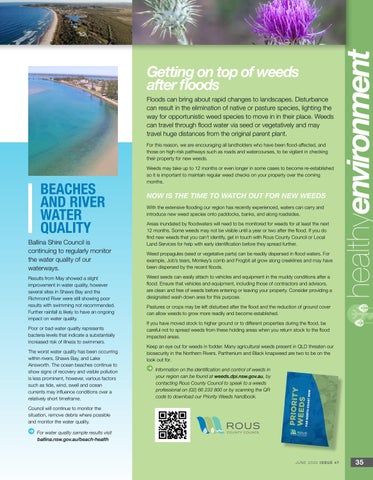Floods can bring about rapid changes to landscapes. Disturbance can result in the elimination of native or pasture species, lighting the way for opportunistic weed species to move in in their place. Weeds can travel through flood water via seed or vegetatively and may travel huge distances from the original parent plant. For this reason, we are encouraging all landholders who have been flood-affected, and those on high-risk pathways such as roads and watercourses, to be vigilant in checking their property for new weeds.
BEACHES AND RIVER WATER QUALITY Ballina Shire Council is continuing to regularly monitor the water quality of our waterways. Results from May showed a slight improvement in water quality, however several sites in Shaws Bay and the Richmond River were still showing poor results with swimming not recommended. Further rainfall is likely to have an ongoing impact on water quality. Poor or bad water quality represents bacteria levels that indicate a substantially increased risk of illness to swimmers. The worst water quality has been occurring within rivers, Shaws Bay, and Lake Ainsworth. The ocean beaches continue to show signs of recovery and visible pollution is less prominent, however, various factors such as tide, wind, swell and ocean currents may influence conditions over a relatively short timeframe.
Weeds may take up to 12 months or even longer in some cases to become re-established so it is important to maintain regular weed checks on your property over the coming months.
NOW IS THE TIME TO WATCH OUT FOR NEW WEEDS With the extensive flooding our region has recently experienced, waters can carry and introduce new weed species onto paddocks, banks, and along roadsides. Areas inundated by floodwaters will need to be monitored for weeds for at least the next 12 months. Some weeds may not be visible until a year or two after the flood. If you do find new weeds that you can’t identify, get in touch with Rous County Council or Local Land Services for help with early identification before they spread further. Weed propagules (seed or vegetative parts) can be readily dispersed in flood waters. For example, Job’s tears, Monkey’s comb and Frogbit all grow along creeklines and may have been dispersed by the recent floods. Weed seeds can easily attach to vehicles and equipment in the muddy conditions after a flood. Ensure that vehicles and equipment, including those of contractors and advisors, are clean and free of weeds before entering or leaving your property. Consider providing a designated wash down area for this purpose.
engaged leadership healthy environment healthyenvironment
Getting on top of weeds after floods
Pastures or crops may be left disturbed after the flood and the reduction of ground cover can allow weeds to grow more readily and become established. If you have moved stock to higher ground or to different properties during the flood, be careful not to spread weeds from these holding areas when you return stock to the flood impacted areas. Keep an eye out for weeds in fodder. Many agricultural weeds present in QLD threaten our biosecurity in the Northern Rivers. Parthenium and Black knapweed are two to be on the look out for. Information on the identification and control of weeds in your region can be found at weeds.dpi.nsw.gov.au, by contacting Rous County Council to speak to a weeds professional on (02) 66 233 800 or by scanning the QR code to download our Priority Weeds handbook.
Council will continue to monitor the situation, remove debris where possible and monitor the water quality. For water quality sample results visit ballina.nsw.gov.au/beach-health
JUNE 2022 ISSUE 47
35











































